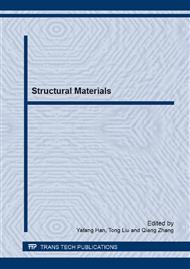p.569
p.573
p.580
p.588
p.593
p.598
p.604
p.608
p.613
Preparation and Microstructure Characterizations of Novel C/C-Zr(Hf)B2-Zr(Hf)C-SiC Composites
Abstract:
A series of novel C/C-Zr (Hf)B2-Zr (Hf)C-SiC composites were prepared by chemical vapor infiltration (CVI) of pyrolytic carbon and polymeric impregnation and pyrolysis (PIP) with hybrid polymeric precursors of SiC (polycarbosilane), Zr (Hf)C and Zr (Hf)B2 in carbon fiber preforms. The formed ultra-high temperature ceramics (UHTCs) matrix of SiC-ZrC-ZrB2 and SiC-HfC-HfB2 were designed to improve the oxidation resistance of carbon/carbon composite at very high temperatures above 2000°C. The pyrolysis process of Zr (Hf)C and Zr (Hf)B2 polymeric precursors was investigated, and the results showed that the hybrid precursors could be successfully transformed into Zr (Hf)C and Zr (Hf)B2 ceramic particles with the sizes of nanometer with temperatures above 1500°C. Furthermore, the multiscale structure of C/C-Zr (Hf)B2-Zr (Hf)C-SiC composites were also characterized , showing that the carbon fibers were covered by pyrolytic carbon, and the continuous ceramic matrix was well dispersed, formed by Zr (Hf)C and Zr (Hf)B2 nanoparticles distributing homogeneously in the continuous SiC matrix. This homogeneous dispersion of composite ceramics of Zr (Hf)C and Zr (Hf)B2 with SiC plays excellent protection of C/C composites from oxidation at high temperature via formation of stable oxides coatings.
Info:
Periodical:
Pages:
593-597
Citation:
Online since:
April 2014
Authors:
Price:
Сopyright:
© 2014 Trans Tech Publications Ltd. All Rights Reserved
Share:
Citation:


